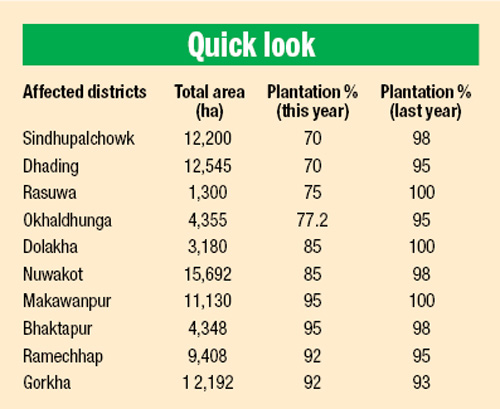Quake-hit districts at risk of food insecurity
Kathmandu, August 31
The earthquake-hit districts might face higher magnitude of food insecurity this year as paddy plantation has remained low in these districts compared to the previous fiscal year due to displacement of settlements, loss of seeds and oxen that used to plough the fields and income shocks on rural families.
Despite unfavourable monsoon, paddy plantation had been carried out on over 90 per cent of the total plantation area in the quake affected districts last fiscal. However, plantation remained substantially low this year, according to the Ministry of Agricultural Development (MoAD).
Among the worst-affected 14 districts, paddy plantation remained significantly low in Sindhupalchowk and Dhading districts. Of the total arable land of 12,200 hectares in Sindhupalchowk and 12,545 hectares in Dhading, paddy plantation has been carried out on only 70 per cent in each district.
Likewise, paddy plantation has been carried out on 75 per cent of total 1,300 hectares in Rasuwa district compared to cent per cent in last fiscal. In Nuwakot, paddy plantation has been carried out on 85 per cent of 15,692 hectares, compared with 98 per cent of the previous year.
Paddy plantation situation is at the similar level of last fiscal in earthquake affected districts of Kavre, Sindhuli and Ramechhap.
Over 90 per cent of paddy plantation area has been already cultivated, as per MoAD.
However, paddy plantation has remained low in Bhaktapur and Makawanpur compared to previous fiscal. In Bhaktapur, only 95 per cent of total 4,348 hectares has been cultivated compared to cent per cent in previous fiscal. Similarly, paddy plantation has been carried out on 95 per cent of total 11,130 hectares in Makawanpur compared to cent per cent of previous year.
Paddy cultivation has been carried out on 92 per cent of 12,192 hectares in Gorkha district, the epicentre of the April 25 devastating quake, compared to 93 per cent of previous fiscal.
“Due to the devastating earthquake and subsequent powerful aftershocks, focus of the earthquake affected households shifted towards managing shelters and other immediate needs rather than on preparing seedbeds for paddy plantation,” Shankar Sapkota, joint spokesperson for the MoAD told The Himalayan Times, adding, “The dismal results of paddy plantation this fiscal is merely the result of the difficult situation brought on by the natural disaster.”
He further added that though the contribution of these districts to the total production is nominal — around five per cent of the total output — it is crucial to meet the food demand of the households in the districts that are dependent on agriculture for subsistence.
The paddy plantation situation supports the projection of the Nepal Food Security Monitoring System (NeKSAP) — which monitors the food security position in collaboration of the World Food Programme in Nepal and MoAD. In its recent report, NeKSAP had said that 259 VDCs of quake-hit districts are at the risk of food insecurity.






